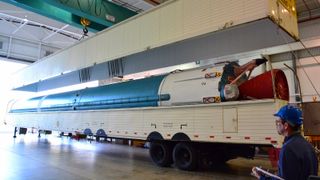Two Defence Department space projects 50 years apart have neat parallels. On 29 November 1967, Australia’s first satellite, WREsat, developed by a forerunner of the Defence Science and Technology Group, was launched from Woomera. Last week, Buccaneer RRM, a small satellite built by DST Group and the University of New South Wales, was launched from California.
The strategic space environment has changed over the intervening years, as Malcolm Davis wrote recently. At the time of WREsat, space was a ‘sanctuary’ accessible to only a handful of powers. All considered space to be fundamentally intertwined with nuclear capability and off limits short of all-out war.
A trifecta of factors threaten space stability: Western powers rely on satellite capabilities more than ever; a growing number of groups can interfere with or destroy satellites; and standards of acceptable behaviour in space haven’t been established.
Now, a trifecta of factors threaten space stability: Western powers rely on satellite capabilities more than ever; a growing number of groups can interfere with or destroy satellites; and standards of acceptable behaviour in space haven’t been established. Add to that mix accidental hazards like space debris and solar storms, and conflict is a real possibility.
At a recent National Space Council meeting, US Vice President Mike Pence was remarkably blunt: ‘Russia and China … are considering attacks against satellite systems as part of their future warfare doctrine.’ Other speakers, including former NASA Administrator Mike Griffin, emphasised that the response ‘must include allies’. Although it might surprise those steeped in Star Wars visions of billion-dollar space projects, less well-resourced allies can play a disproportionally influential role in modern space security.
So what should Australia’s role be? We should participate where our contributions are magnified beyond their dollar value by lenses of geography, national sovereignty, capability and agility.
The geographical contributions are most obvious. Australia has historically leveraged geography for satellite command, control and communications at Pine Gap, and more recently for space situational awareness (SSA) in Western Australia. An expanded contribution to SSA makes sense, and defence planning acknowledges this with a $1–2 billion indicative spend to 2035 (under the integrated investment program). An Australian SSA focus would build on existing civilian space capabilities and Australia’s strengths in observational astronomy. Adding sensors across Australia and its outlying territories would increase the timeliness and accuracy of SSA information, give Australia a leading role in integrating SSA data across the Five Eyes community, and potentially lead to commercial applications.
Australia needs to develop its own space policy to benefit its own interests. Canberra and Washington have a close alliance, but that doesn’t mean Australia should merely await instructions.
We can also contribute by promoting a rules-based order in space. The existing framework for activity in space, enshrined in treaties that are nearly 50 years old, is dangerously outmoded and lacks clear standards for responsible behaviour by states. Yet, as a recent paper from the Pentagon argues, norms are a critical part of a deterrence strategy. Consistent Australian participation in relevant forums—especially in our region—can help shape the ‘rules of the road’ to the benefit of Australia and its allies. Australia has that capability; we recently made important contributions to clarifying how the laws of war apply to space and we have a history, albeit patchy, of participating in relevant UN committees.
Australia’s strong niche capabilities, particularly in remote sensing, could develop useful satellites or satellite payloads. These would further diversify space-based assets across the Five Eyes and create a conflict-resilient architecture. Australia’s intention to invest in a remote-sensing capability is a positive step that builds on those existing national strengths. The scope of these ‘space hardware’ contributions will increase if our space industrial base develops on the back of a civilian agency.
Finally, Australia’s relatively small industry, so often a limiting factor, can be a positive influence. The US is challenged to innovate fast in space and is experimenting with new organisational structures. Our efforts lack much of the industrial baggage the US carries and can point the way. Joint innovation centres on both sides of the Pacific could be established to rapidly develop new capabilities, and similar work is underway in Canada.
These contributions would reinforce each other. Better SSA capabilities promote transparency, which helps enforce norms. More space capability develops greater ‘skin in the game’, which boosts our ability to shape norms. Innovation leads to more effective space hardware, and so on.
To make the most of the opportunity, though, three changes in mindset would help.
First, the civil space agency must be established and staffed to credibly contribute to national security discussions. Key areas of SSA, norms and remote sensing span the civil–military divide. Our space efforts are too small for the left hand to be unaware of what the right hand is doing.
Second, Australia needs to develop its own space policy to benefit its own interests. Canberra and Washington have a close alliance, but that doesn’t mean Australia should merely await instructions. Rather, we should identify trends, develop forward-thinking plans, talk with allies and move ahead. Australian contributions grounded in independent thought will be the most welcome.
Finally, we should identify the capabilities that will accelerate development of our civil and military space sectors and use our relationship with the US to grow them. A strong Australian space sector benefits both countries, and the strength of the relationship offers a stepping stone to an unprecedented but appropriate level of Australian space capability.
Such a goal was no doubt in the minds of the WREsat team 50 years ago. We have a chance to realise it today.






